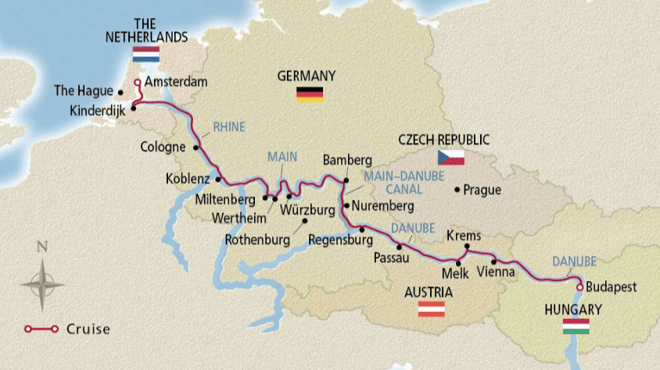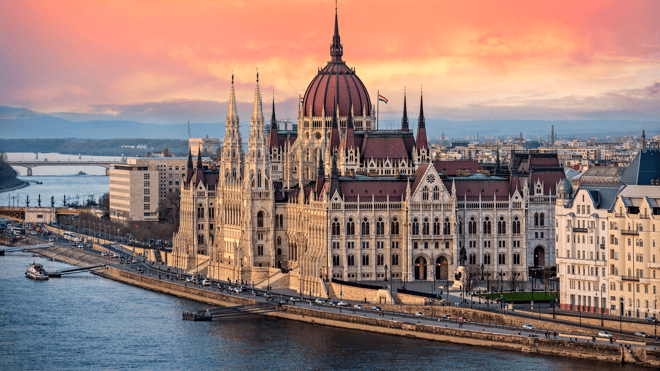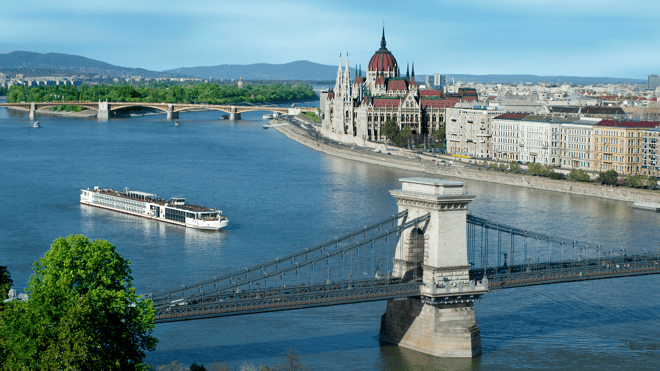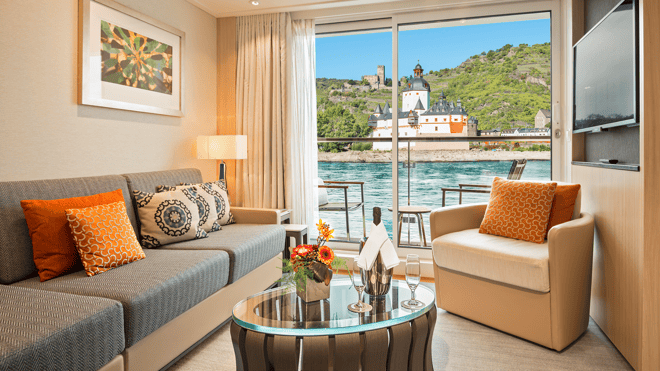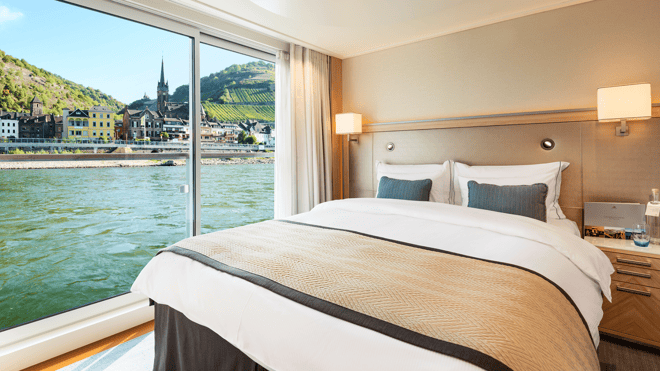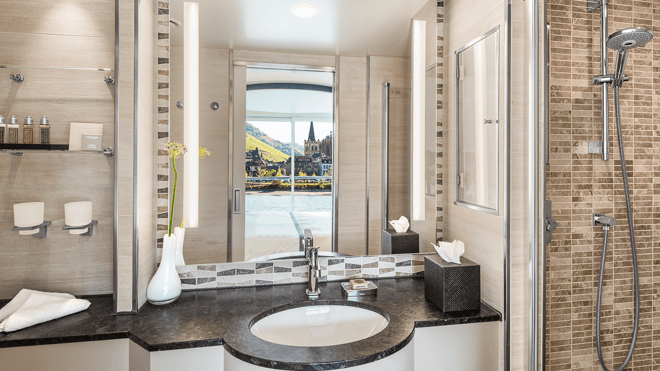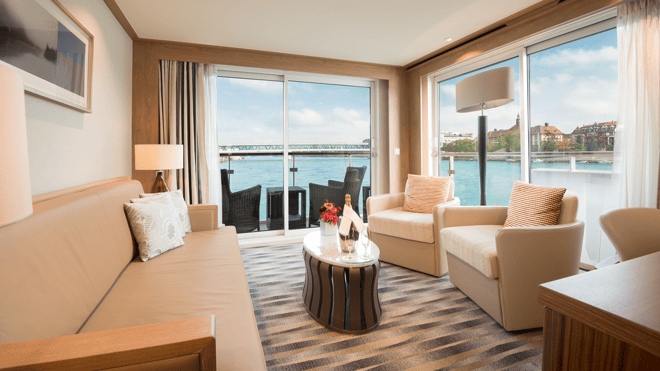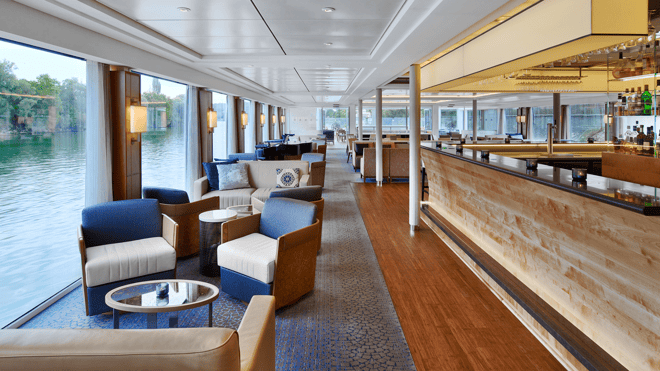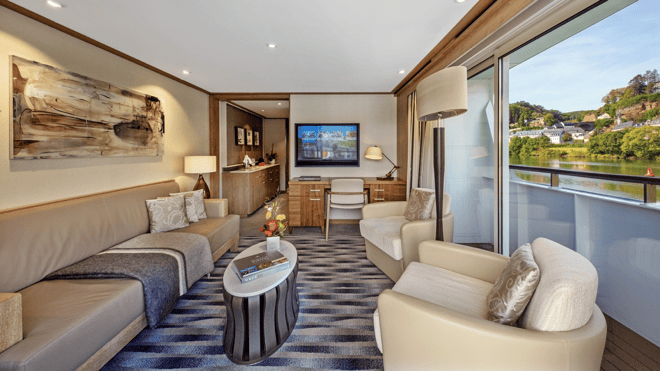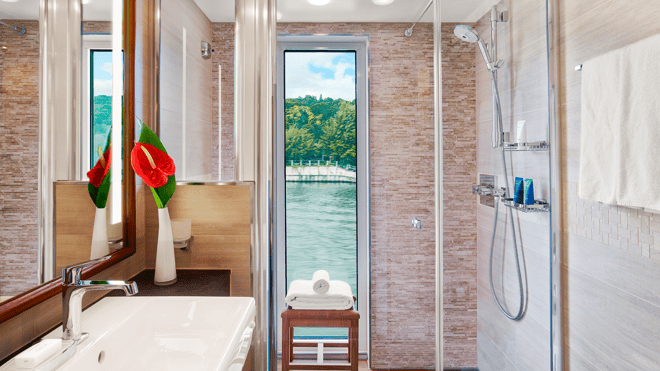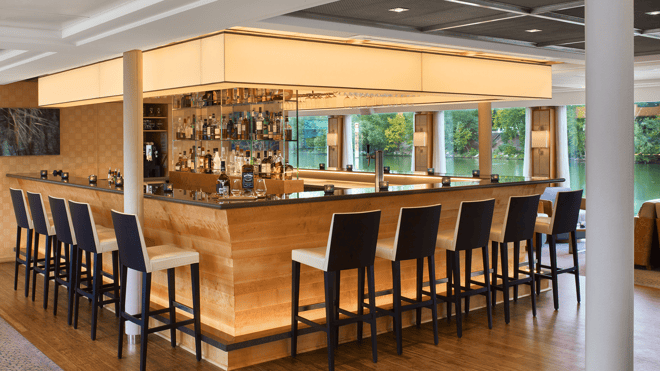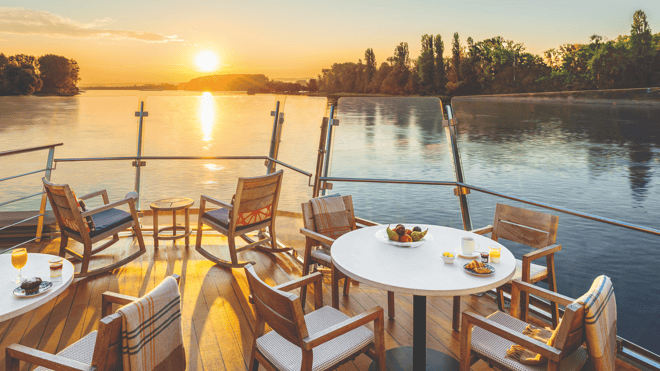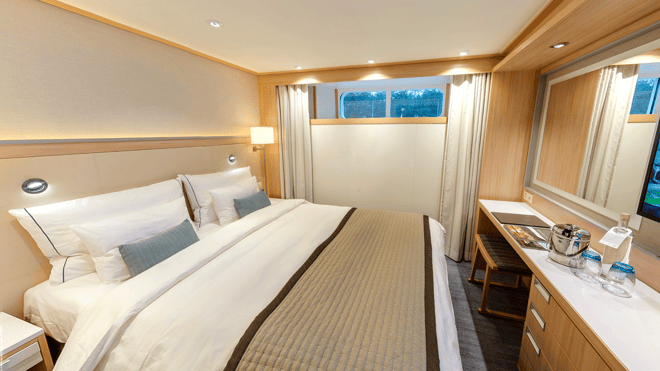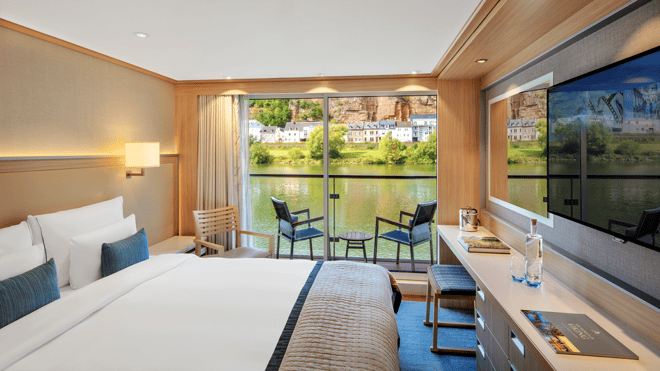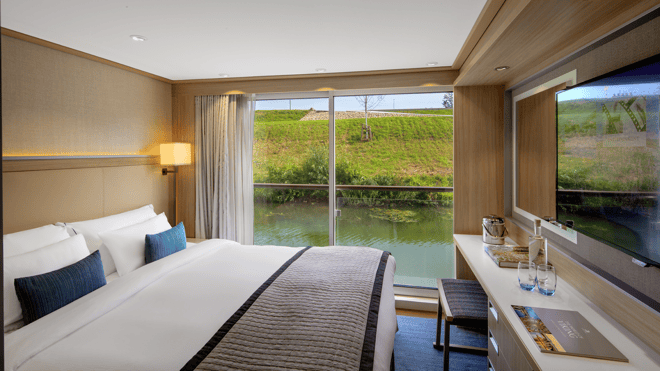Cruise Amsterdam to Budapest
Travel through the heart of Europe
Admire Rhine Valley vistas from a 900-year-old castle. Sample the culinary delights of Austria’s Wachau Valley. Learn the Viennese waltz, visit Melk’s Benedictine Abbey, and ponder Nuremberg’s World War II history. Indulge your senses on this 15-day journey spanning the best of Europe, tracing the Rhine, Main, and Danube Rivers between the windmill-dotted waterways of Holland and the stunning landscapes of Hungary, with engaging encounters at every bendz
More features, services and excursions included
- One complimentary shore excursion in every port of call
- Free Wi-Fi (connection speed may vary)
- All onboard meals, featuring regional specialties & always available classics
- Beer, wine & soft drinks with onboard lunch & dinner
- 24-hour specialty coffees, teas & bottled water
- Port taxes & fees
- Ground transfers with Viking Air purchase
- Visits to UNESCO Sites
- Enrichment lectures & Destination Performances
- Onboard gratuities
Your fare excludes:
- Airfares & travel insurance
Sample itinerary
Day 1: Budapest, Hungary
Embark your ship and settle into your stateroom. Riverside beauty and a vibrant cultural scene blend together in Budapest to form one of Europe’s most rewarding cities. Hungary’s enchanting capital straddles the banks of the Danube, with traditional hillside Buda on one side and modern Pest on the other. By day, stunning art nouveau buildings, stalwart castles and grand palaces set the stage for inspiring strolls and long soaks in thermal spas. By night, the shimmering lights of the Parliament building dance across the waters of the Danube, the Chain Bridge uniting it all as a dramatic centerpiece.
* Ground transfers are included with Viking Air purchase.
Day 2: Budapest, Hungary
Budapest’s old town is a fascinating medieval patchwork of narrow streets and colorful houses. In the Castle District, the Matthias Church soars in Gothic glory. Adjacent, the expansive wall and seven turrets of Fisherman’s Bastion overlook the Danube, the graceful Chain Bridge and the Pest side of the river. The centerpiece of the district is the sprawling Buda Castle. Constructed in the 13th century and expanded to its current baroque splendor during the 18th century, this edifice was home to Hungary’s kings for almost 700 years.
Day 3: Vienna, Austria
Renowned as the “City of Waltzes,” Austria’s capital city of Vienna is Europe’s center of classical music. Strauss and Mozart composed many of their finest pieces here. Vienna’s musical history is matched by the elegant, graceful architecture that lines the Ringstrasse, the wide boulevard encircling the Inner City. Baroque, neo-Renaissance, Gothic-Romanesque and other splendidly styled structures, from the Hofburg Palace to the Vienna State Opera, take the breath away with their grand facades. Vienna has a more intimate side too: inviting footpaths lead through green parks and its famed Viennese cafés sweeten any stay with coffee and the city’s delectable Sachertorte.
Day 4: Vienna, Austria
Vienna is considered one of Europe’s greatest cultural hubs. Its art scene has long been established with the Hapsburg’s collection of fine art, now housed at the Kunsthistorisches Museum. Today, Vienna’s modern side showcases street art murals that don the side of buildings along the banks of the Danube. Ingrained in local life is the long-embraced tradition of coffeehouses; UNESCO includes Viennese coffeehouse culture on its list of Intangible Cultural Heritages. It is considered one of life’s pleasures to while away an afternoon over an Einspänner coffee and a pastry.
Day 5: Scenic Sailing - Wachau Valley
Sail through a serene tapestry of terraced vineyards, forested slopes, charming towns and castle ruins in Austria’s Wachau Valley, celebrated as perhaps the most scenic stretch of the Danube. Journey 18 miles through this vast UNESCO World Heritage Site, where the river courses through picturesque hillsides. Gaze upon the prolific grapevines and quaint wine-producing villages hugging the shores—the legacy of vintners that stretch as far back as Celtic and Roman times and an echo of the more than 30 monasteries that served as vineyards in Renaissance days.
Day 6: Passau, Germany
Founded by the Celts over 2,000 years ago, Passau is one of Bavaria’s oldest cities. Known as the “City of Three Rivers,” it rests at the confluence of the Inn, Ilz and Danube rivers. The city has long enjoyed its strategic position and grew to great economic and political power because of it. The legacy of its past prosperity lives on in graceful arcades, colorful houses with rococo facades and the glorious baroque St. Stephen’s Cathedral, home to one of Europe’s largest pipe organs. Passau is also where two nations meet; it is here that the German-Austrian border begins.
Day 7: Regensburg, Germany
Having escaped major damage during World War II, the picturesque town of Regensburg is one of Europe’s best-preserved medieval cities, the oldest city along the Danube and a UNESCO World Heritage Site. The Old Stone Bridge, constructed in the 12th century, is a masterpiece of medieval engineering with its 16 arches. St. Peter’s Cathedral is widely considered Bavaria’s best Gothic architectural work. The old town’s Neupfarrplatz square is a cross section of history—it was once a thriving Jewish quarter, a bustling marketplace and the site of Nazi book burnings.
Day 8: Scenic Sailing - Main-Danube Canal, Germany
As far back as 1,200 years ago, visionary Frankish Emperor Charlemagne contemplated connecting the Rhine, Main and Danube Rivers so ships could travel the length of Europe. Today, his dream dramatically comes to life. The Main-Danube Canal employs 16 stair-step river locks that allow vessels to travel 2,200 miles through 10 countries, from the North Sea coast of Holland to the Black Sea shores of Romania.
Day 9: Bamberg, Germany
Founded in 902, Bamberg remains a medieval-looking city known for its symphony orchestra and rauchbier, specialty smoked beer. The city’s winding streets are filled with baroque patrician houses and are home to the stunning 11th-century Cathedral of Holy Roman Emperor Heinrich II, housing his tomb and that of Pope Clement II. Bamberg is especially noted for its Altes Rathaus, or Old Town Hall, situated on a twin-arched bridge over the Regnitz River, and for the old bishop’s houses: the 16th-century Alte Hofhaltung (Old Court) and 17th-century Neue Residenz (New Residence).
Day 10: Würzburg, Germany
Surrounded by Franconian vineyards, Würzburg was heavily damaged during World War II, but has since been completely restored. This prestigious university city is a jewel of baroque architecture. Its most pristine example of pomp and glory is the great Bishops’ Residenz palace, built in 1744 for the prince-bishop; his unwavering support of artists is evidenced by the sweeping staircase and magnificent ceiling frescoes by Tiepolo. Other landmarks include the medieval, statue-lined Old Main Bridge and Marienberg Fortress, originally a Celtic hill fort and later residence of the bishops. The city remains a major wine-making center, hosting Germany’s oldest and largest vineyard.
Day 11: Wertheim, Germany
Situated at the confluence of the Main and Tauber Rivers, Wertheim is a charming town brimming with history. The dukes of Wertheim built a castle at this strategic spot in the 12th century. It was captured and destroyed during the Thirty Years’ War, but it is still impressive today, peering down upon the medieval town center and half-timbered houses from its perch. Its Pointed Tower has guarded the junction of the Main and Tauber Rivers for 800 years. Known as a successful merchants’ town during the Middle Ages, today Wertheim is famous for its Franconian wines.
Day 12: Scenic Sailing - Middle Rhine
The Rhine River flows through one of Germany’s most scenic regions. As you sail its most picturesque stretch, the UNESCO World Heritage Site of the Middle Rhine, you will pass vineyard-blanketed hills whose steep slopes require vintners to pick grapes by hand, keeping a centuries-old tradition alive. Splendid castles line the banks, all of which have stories to share, and the Lorelei Rock presides at a dramatic curve in the river. This infamous river maiden mesmerized sailors with her song and lured them to their demise at her feet.
Day 13: Cologne, Germany
Cologne reveals its Roman heritage in its city layout and the ancient ruins that lie scattered through the town. Cologne’s modern plazas and Hohe Strasse host welcoming shops, enticing restaurants and cologne boutiques. Of note is the city’s 13th-century cathedral, a stunning example of Gothic artistry and a UNESCO World Heritage Site. Having survived Allied bombs during World War II, the cathedral’s imposing twin spires are visible for miles and its stained glass windows fill the interior with brilliant colored light. Its steps lead to a platform with astounding views.
Day 14: Scenic Sailing - Waal & Merwede
Sail the bucolic waters of the Rhine, deep into the Rhine–Meuse–Scheldt Delta, as classic Dutch landscapes unfurl all around. Flat farmland, charming windmills and svelte poplar trees line the shores, and vast tracts of land stretch in all directions, growing all manner of bounty, from tomatoes to tulips. Gaze upon Friesian cows and tidy villages with their neatly laid farmhouses and marvel at how much of this land was reclaimed from the sea, with the aid of traditional windmills and the construction of dikes.
Day 15: Amsterdam, The Netherlands
Bid farewell to your fellow guests and journey home. Or spend more time exploring, perhaps joining one of our extensions.
* Ground transfers are included with Viking Air purchase.
Amsterdam to Budapest. Multiple departures available from October 2025 to November 2027
Below price is based on departure on 25 October 2025 on the Viking Bragi.
- Standard (E) from $7,795 pp twin share / $13,641.25 pp sole use*
- Veranda (A) from $12,795 pp twin share / $25,590 pp sole use*
- Veranda Suite (AA) from $18,695 pp twin share / $37,390 pp sole use*
For pricing on alternative departure dates, please call our team on 1300 414 198 today!
*Prices and category availability are subject to change without notice.
Bragi is the Norse god of poetry, music and eloquence. Plucking his harp and singing sweetly, he can charm all creatures, even the flowers and the trees. His tongue is carved with runes, ancient Norse symbols, and through his poetry, Bragi keeps the stories of the gods alive.
- Only 190 guests
- Crew: 53
- Length: 443 feet
- Year built: 2013
Ship Features
- 95 comfortable outside staterooms (25 Standard Staterooms, 22 French Balcony Staterooms, 39 Veranda Staterooms, 7 Veranda Suites, 2 Explorer Suites)
- All suites feature two full-size rooms with a veranda off the living room & a French balcony in the bedroom
- Sun Deck with 360-degree views & shaded sitting area; organic herb garden & solar panels; putting green & walking track
- Aquavit Terrace & Lounge, a revolutionary indoor/outdoor viewing area at the bow of the ship for al fresco dining
- Lounge & Bar with floor-to-ceiling glass doors
- Restaurant with floor-to-ceiling windows for panoramic views
- Library & onboard shop
- Elevator from Middle to Upper Deck only; no elevator access for categories E & F
- Free Wi-Fi (connection speed may vary)
- Laundry service
- Ecologically friendly hybrid engines producing less vibrations for a smoother ride
- Flat-screen TV with infotainment system featuring a selection of live TV channels, complimentary Movies On Demand and in-house programming
Stateroom Features
Our purpose-built ships offer a wide variety of staterooms for your selection. From Veranda Staterooms to the abundance of extra perks and amenities in our spacious Explorer Suites, there is no finer way to travel. And whichever stateroom you choose, you will find it beautifully designed in the understated elegance for which Viking is known.
Dining & Entertainment- On your ship, you can expect spacious, airy public areas and abundant options for al fresco dining. Also, on our ocean and expedition voyages, as always, you can enjoy complimentary 24-hour room service. Now, more options for spaced seating in all dining venues will allow for physical distancing; there will be additional table service at all bars and lounges; and new capabilities will allow you to watch more live events and enriching content through your in-room entertainment system.
Physical Distancing & Face Masks - Public health experts agree that proper physical distancing and the use of face masks are effective in helping slow the spread of COVID-19 and other illnesses. Face masks are optional while moving about the ship. Please note: Viking’s Medical Team continually monitors conditions and may deem face masks to be necessary while moving about the ship, based on conditions at the time of travel. While ashore, guests will need to comply with any local guidelines for face masks and physical distancing. Face masks continue to be required for all crew.
Shore Excursions & Exploration- We have redesigned our land program, limiting group size and will continue to monitor conditions in each destination. All shore excursion motor coaches are fully sanitised. Face masks are recommended for guests on shore excursions, unless otherwise required to comply with local regulations. Guests may explore independently while following requirements in the country they are visiting.
